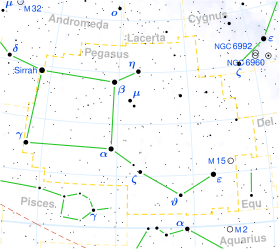56 Pegasi
| Observation data Epoch J2000 Equinox J2000 | |
|---|---|
| Constellation | Pegasus |
| Right ascension | 23h 07m 06.73908s[1] |
| Declination | 25° 28′ 05.7329″[1] |
| Apparent magnitude (V) | 4.74[2] |
| Characteristics | |
| Spectral type | K0IIp + sdO[3][4] |
| U−B color index | +1.14[2] |
| B−V color index | +1.32[2] |
| Astrometry | |
| Radial velocity (Rv) | -27.55[5] km/s |
| Proper motion (μ) | RA: -0.03[1] mas/yr Dec.: -33.07[1] mas/yr |
| Parallax (π) | 5.51 ± 0.23[1] mas |
| Distance | 590 ± 20 ly (181 ± 8 pc) |
| Absolute magnitude (MV) | −1.32[6] |
| Details | |
| Mass | 5.4[7] M☉ |
| Luminosity | 680[8] L☉ |
| Surface gravity (log g) | 0.50[9] cgs |
| Temperature | 4,416[10] K |
| Metallicity [Fe/H] | -0.21[8] dex |
| Rotational velocity (v sin i) | 4.4[11] km/s |
| Other designations | |
| Database references | |
| SIMBAD | data |
56 Pegasi (56 Peg) is a spectroscopic binary star in the constellation Pegasus. Its apparent magnitude is 4.74[2] and it is approximately 590 light years away based on parallax.[1]
The companion, a subdwarf O star, has a period of about 111 days.[4]
References
- 1 2 3 4 5 6 Van Leeuwen, F. (2007). "Validation of the new Hipparcos reduction". Astronomy and Astrophysics. 474 (2): 653. arXiv:0708.1752. Bibcode:2007A&A...474..653V. doi:10.1051/0004-6361:20078357. Vizier catalog entry
- 1 2 3 4 Ducati, J. R. (2002). "VizieR Online Data Catalog: Catalogue of Stellar Photometry in Johnson's 11-color system". CDS/ADC Collection of Electronic Catalogues. 2237. Bibcode:2002yCat.2237....0D.
- ↑ Simon, T.; Linsky, J. L.; Stencel, R. E. (1982). "On the reality of a boundary in the H-R diagram between late-type stars with and without high temperature outer atmospheres". Astrophysical Journal. 257: 225. Bibcode:1982ApJ...257..225S. doi:10.1086/159981.
- 1 2 Griffin, R. F. (2006). "Spectroscopic binary orbits from photoelectric radial velocities - Paper 186: 56 Pegasi". The Observatory. 126: 1. Bibcode:2006Obs...126....1G.
- ↑ Famaey, B.; Jorissen, A.; Luri, X.; Mayor, M.; Udry, S.; Dejonghe, H.; Turon, C. (2005). "Local kinematics of K and M giants from CORAVEL/Hipparcos/Tycho-2 data". Astronomy & Astrophysics. 430: 165. arXiv:astro-ph/0409579. Bibcode:2005A&A...430..165F. doi:10.1051/0004-6361:20041272.
- ↑ Frankowski, A.; Jorissen, A. (2006). "The puzzling case of 56 Pegasi: A fast rotator seen nearly pole-on". The Observatory. 126: 25. arXiv:astro-ph/0512036. Bibcode:2006Obs...126...25F.
- ↑ Tetzlaff, N.; Neuhäuser, R.; Hohle, M. M. (2011). "A catalogue of young runaway Hipparcos stars within 3 kpc from the Sun". Monthly Notices of the Royal Astronomical Society. 410: 190. arXiv:1007.4883. Bibcode:2011MNRAS.410..190T. doi:10.1111/j.1365-2966.2010.17434.x. Vizier catalog entry
- 1 2 Anderson, E.; Francis, Ch. (2012). "XHIP: An extended hipparcos compilation". Astronomy Letters. 38 (5): 331. arXiv:1108.4971. Bibcode:2012AstL...38..331A. doi:10.1134/S1063773712050015. Vizier catalog entry
- ↑ Soubiran, Caroline; Le Campion, Jean-François; Brouillet, Nathalie; Chemin, Laurent (2016). "The PASTEL catalogue: 2016 version". Astronomy & Astrophysics. 591: A118. arXiv:1605.07384. Bibcode:2016A&A...591A.118S. doi:10.1051/0004-6361/201628497.
- ↑ Martínez, M. Isabel Pérez; Schröder, K.-P.; Cuntz, M. (2011). "The basal chromospheric Mg ii h+k flux of evolved stars: Probing the energy dissipation of giant chromospheres". Monthly Notices of the Royal Astronomical Society. 414: 418. arXiv:1102.4832. Bibcode:2011MNRAS.414..418P. doi:10.1111/j.1365-2966.2011.18421.x. Vizier catalog entry
- ↑ De Medeiros, J. R.; Mayor, M. (1999). "A catalog of rotational and radial velocities for evolved stars". Astronomy and Astrophysics Supplement Series. 139 (3): 433. arXiv:astro-ph/0608248. Bibcode:1999A&AS..139..433D. doi:10.1051/aas:1999401. Vizier catalog entry
This article is issued from
Wikipedia.
The text is licensed under Creative Commons - Attribution - Sharealike.
Additional terms may apply for the media files.
